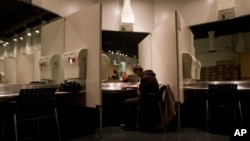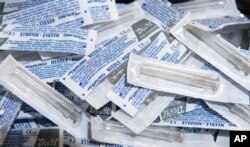Canada is attacking its expanding opioid crisis with an unusual measure: It’s giving addicts a safe place to shoot up.
The government has allowed seven “safe injection sites” to open and a score of others are being considered across the country.
The storefront sites give addicts clean syringes, medical supervision and freedom from arrest. They don’t get help in kicking their problem unless they ask for it, but the program dramatically reduces the chance of a fatal overdose or the transmission of blood-borne diseases such as hepatitis or HIV.
The effort, inspired by some in Europe, is being closely watched in the U.S., where officials are struggling to cope with a surge in overdose deaths from opioid use. Several cities say they are considering similar measures despite fears that they may encourage drug use.
First center in Vancouver
Dozens of people a day have been coming to three new centers in Montreal, where users are given a small kit to safely inject drugs they bring with them and then an opportunity to relax for a half hour on couches listening to music, according to a 30-year-old addict who would only give his first name, Francois. The center operators denied access to the media once the center opened.
“They give you everything you need,” Francois said as he left a center in the gentrifying downtown neighborhood around Sainte-Catherine Street after injecting heroin. “Everyone is pretty relaxed.”
A single injection site opened in 2003, run by a Vancouver nonprofit organization under authorization by Health Canada. It received 214,898 visits by 8,040 individuals last year, with nurses intervening in 1,781 overdoses. It said it’s never had an overdose death.
Another center also has opened in that West Coast city, and in recent weeks, two more have opened in British Columbia and three in Montreal. Another is scheduled to open in Montreal soon and three in Toronto. More than a dozen other potential sites are being considered across Canada federal officials say.
More overdoses prompt more centers
Health Minister Jane Philpott said the government felt compelled to add sites because of the escalating number of overdose deaths, which topped 2,400 last year.
“They are absolutely known to save lives and reduce infections,” Philpott said. “We have a very significant public health issue in our country.”
She acknowledged they are not a complete answer to the drug problem: “This is only one in a very broad range of tools. A comprehensive approach is necessary.”
Seattle to open centers
U.S. drug overdose deaths have tripled in 15 years, reaching at least 52,000 in 2015, making it the leading cause of death for people under 50. Seattle and King County in Washington are moving forward with plans for safe injection centers and a city task force in Philadelphia has proposed some, though such measures have faced opposition.
John Walters, who directed the White House Office of National Drug Control Policy under President George W. Bush, said safe-injection sites merely prolong addiction and eventually lead to deaths.
He noted that overdose deaths have risen sharply in British Columbia despite the presence of the first safe-injection site in North America. The province had 136 deaths in April, a 97 percent increase over the same month a year earlier. There were 967 overdose deaths in British Columbia in 2016, up from 517 in 2015. And there have been 640 this year through May.
“Government-sanctioned injection sites are now said by advocates to prevent overdose deaths. That clearly has not happened in British Columbia,” Walters said.
Jonathan Caulkins, a drug policy expert at Carnegie Mellon University in Pittsburgh, isn’t convinced they work either but said he understands their appeal.
“The opioid crisis is so horrible that you are desperate and willing to try anything,” he said. “There’s a part of me that says, ‘Sure, give it a shot.”’
Neighbors not pleased
Gilles Beauregard, executive director of a Montreal safe injection site opening in September, argued that the service will help neighborhoods.
“At street level, we’re going to see a decrease in the number of needles lying around, and less people shooting up in parks and alleys and public toilets,” he said.
Not everybody living nearby agrees. Angry residents met Montreal Mayor Denis Coderre and other officials when they inaugurated the Sainte-Catherine Ease facility in late June. Chantal Beauregard, who lives in the area, said it has attracted junkies at all hours and needles now litter the ground.
“It’s been one week and we’re already fed up,” she said.
A new safe injection facility scheduled to open a mile east in Montreal in September is also drawing criticism
“Having a supervised injection site in a school zone doesn’t make sense,” says Christelle Perrine, who has two children in a school about 200 yards (meters) from the facility.
A tall, broad-shouldered and extensively tattooed man who gave his name only as Benjamin was among about a dozen drug users who made their way to the Sainte-Catherine East injection site over an hour one midweek day.
“I’ve been waiting for something like this for years. It’s great. You don’t have junkies shooting up everywhere, leaving their needles all over the place,” the 46-year-old said after injecting cocaine. “It’s clean, the staff is great.”
“I understand why people who live around here aren’t happy. I have a heart and I have a brain,” he said. “My life’s ambition wasn’t to do this, but at least with this, we’re safe.”













